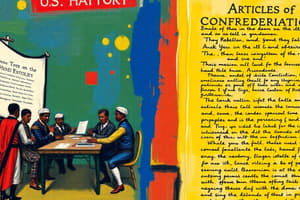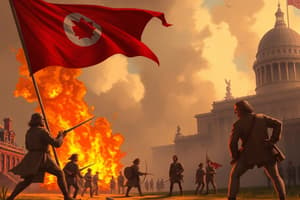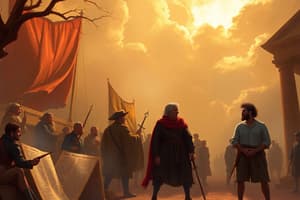Podcast
Questions and Answers
According to Harold Laswell, what is the definition of politics?
According to Harold Laswell, what is the definition of politics?
- The struggle over who gets what, when, and how. (correct)
- The process of electing officials to represent the populace.
- The philosophical debate over the ideal form of government.
- The establishment and enforcement of laws and policies.
Which of the following best describes the central issue that led to Shays' Rebellion?
Which of the following best describes the central issue that led to Shays' Rebellion?
- Farmers protesting debt and taxation. (correct)
- Conflicts between loyalists and patriots after the Revolutionary War.
- Federal overreach in regulating interstate commerce.
- Disputes over westward expansion and land ownership.
What was the primary aim of those who convened the Constitutional Convention of 1787?
What was the primary aim of those who convened the Constitutional Convention of 1787?
- To elect the first President of the United States.
- To draft the Declaration of Independence from Great Britain.
- To revise the Articles of Confederation. (correct)
- To establish a new system of currency and trade regulations.
The Three-Fifths Compromise directly concerned the issue of representation in Congress, but what indirect effect did it have?
The Three-Fifths Compromise directly concerned the issue of representation in Congress, but what indirect effect did it have?
Which of the following was a significant weakness of the Articles of Confederation?
Which of the following was a significant weakness of the Articles of Confederation?
In the debate over representation in the new legislature, which of the following proposals favored the larger states by basing representation on population?
In the debate over representation in the new legislature, which of the following proposals favored the larger states by basing representation on population?
If the federal government levies income taxes, and a state government taxes the sale of goods, what constitutional principle is being demonstrated?
If the federal government levies income taxes, and a state government taxes the sale of goods, what constitutional principle is being demonstrated?
The Tenth Amendment to the Constitution defines which of the following?
The Tenth Amendment to the Constitution defines which of the following?
Which of the following scenarios best illustrates the government's use of eminent domain?
Which of the following scenarios best illustrates the government's use of eminent domain?
Beyond explicit wording, how are implied powers derived within the context of the U.S. Constitution?
Beyond explicit wording, how are implied powers derived within the context of the U.S. Constitution?
Which of the following best describes the concept of inherent powers?
Which of the following best describes the concept of inherent powers?
Which statement accurately differentiates dual federalism from cooperative federalism?
Which statement accurately differentiates dual federalism from cooperative federalism?
How does the Supremacy Clause in the Constitution resolve conflicts between state and federal laws?
How does the Supremacy Clause in the Constitution resolve conflicts between state and federal laws?
The Tenth Amendment is often referred to as the 'reserved powers clause.' What does this imply for the division of power between the federal and state governments?
The Tenth Amendment is often referred to as the 'reserved powers clause.' What does this imply for the division of power between the federal and state governments?
Consider a state law that contradicts a federal law regarding interstate commerce. Which clause of the Constitution would most likely be invoked to resolve this conflict?
Consider a state law that contradicts a federal law regarding interstate commerce. Which clause of the Constitution would most likely be invoked to resolve this conflict?
What is the significance of the Necessary and Proper Clause (Elastic Clause) in the U.S. Constitution?
What is the significance of the Necessary and Proper Clause (Elastic Clause) in the U.S. Constitution?
How does the Full Faith and Credit Clause impact the relationship between states?
How does the Full Faith and Credit Clause impact the relationship between states?
The Privileges and Immunities Clause prevents a state from discriminating against citizens of other states. Which of the following scenarios would most likely be a violation of this clause?
The Privileges and Immunities Clause prevents a state from discriminating against citizens of other states. Which of the following scenarios would most likely be a violation of this clause?
What is the relationship between the protections offered by the Fourth Amendment and the concept of individual privacy?
What is the relationship between the protections offered by the Fourth Amendment and the concept of individual privacy?
How does a unitary system of government differ from a federal system, such as that of the United States?
How does a unitary system of government differ from a federal system, such as that of the United States?
Flashcards
Inherent Powers
Inherent Powers
Powers held by a government simply because it exists as a nation.
Federalism
Federalism
A system dividing power between national and state governments.
Dual Federalism
Dual Federalism
Governmental power divided strictly between national and state governments.
Supremacy Clause
Supremacy Clause
Signup and view all the flashcards
Tenth Amendment
Tenth Amendment
Signup and view all the flashcards
Fourth Amendment
Fourth Amendment
Signup and view all the flashcards
Necessary and Proper Clause
Necessary and Proper Clause
Signup and view all the flashcards
Privileges and Immunities Clause
Privileges and Immunities Clause
Signup and view all the flashcards
Three Branches of Government
Three Branches of Government
Signup and view all the flashcards
Electoral College
Electoral College
Signup and view all the flashcards
What is politics?
What is politics?
Signup and view all the flashcards
Who was Thomas Jefferson?
Who was Thomas Jefferson?
Signup and view all the flashcards
What was Shays' Rebellion?
What was Shays' Rebellion?
Signup and view all the flashcards
What was the Constitutional Convention's purpose?
What was the Constitutional Convention's purpose?
Signup and view all the flashcards
What was the 3/5th Compromise?
What was the 3/5th Compromise?
Signup and view all the flashcards
Under the Articles of Confederation?
Under the Articles of Confederation?
Signup and view all the flashcards
What is a Concurrent Power?
What is a Concurrent Power?
Signup and view all the flashcards
What is reserved power?
What is reserved power?
Signup and view all the flashcards
What is eminent domain?
What is eminent domain?
Signup and view all the flashcards
What are expressed powers?
What are expressed powers?
Signup and view all the flashcards
Study Notes
-
Politics involves the struggle over resources
-
Determines who gets what, when, and how
-
Thomas Jefferson wrote the Declaration of Independence
-
Amendment proposals require a 2/3rd vote in both the House and Senate
-
Shay's Rebellion involved farmers protesting debt and taxation
-
It highlighted the weaknesses of the Articles of Confederation
-
The Constitutional Convention's purpose was to revise the Articles of Confederation
-
The 3/5ths Compromise counted enslaved people as three-fifths of a person
-
This was for representation and taxation purposes
-
Under the Articles of Confederation, each state had one vote
Articles of Confederation
-
Functioned as a league of independent states from 1781-1789
-
It used a unicameral legislature where each state had one vote
-
Passing laws required 9 of 13 states; amendments required 13 of 13
-
It lacked an independent executive or national judicial branch
-
Most power was retained by the states
-
The national government could not tax, raise an army, or regulate commerce/currency
-
The New Jersey Plan proposed a unicameral legislature
-
It provided equal state representation, favoring smaller states
-
The Virginia Plan proposed a bicameral legislature
-
Representation was based on state population, which favored larger states
-
Concurrent powers are shared by national and state governments, like taxation
-
Reserved powers are specifically given to the states
-
The 10th Amendment outlines this
-
Eminent domain is the government's power to take private property for public use
-
Harold Laswell studies who gets what, when, and how
-
The divine right theory asserts that God chooses certain people to rule
-
Thomas Hobbes described life as poor, nasty, brutish, and short
-
Democracy is rule by the people
-
Direct democracy involves citizens voting directly for laws and policies
-
Representative democracy involves electing officials to represent citizens
-
The Supreme Court was created by the Constitution
-
Amendment language requires a two-thirds vote from Senate and House of Representatives.
-
Expressed powers are explicitly listed in the Constitution
-
James Madison, Alexander Hamilton, and John Jay wrote the Federalist Papers
-
Implied powers are reasonably suggested by the Constitution's written powers
-
These are found in Article 1, Section 8
-
Inherent powers are held by a government because it is a nation
-
Federalism divides governmental power between a national and state/regional governments
-
Dual federalism and cooperative federalism are the two types of federalism
-
Dual federalism existed during the time of ratification to the New Deal
-
John Locke argued for natural rights
-
These include life, liberty, and property
-
Anarchists believe there should be no government
-
The Full Faith and Credit Clause (Article IV, Section 1) requires states to honor other states' public acts/legal decisions
-
The Supremacy Clause states that federal law takes precedence over state law when they conflict
-
The Tenth Amendment is known as the reserved power clause
-
The Fourth Amendment protects against unreasonable searches and seizures
-
The First Amendment prohibits Congress from establishing a religion or restricting free exercise
-
Ratifying the new Constitution required 9 of 13 states
-
Delegated power is also known as expressed or enumerated power
-
The USA, Canada, and Switzerland have a federal system of government
-
The Sixth Amendment guarantees the right to an attorney
-
The Necessary and Proper Clause (Article 1, Section 8) allows Congress to make laws needed to use its powers
-
The Privileges and Immunities Clause (Article IV, Section 2) ensures that citizens of each state have the same rights as citizens of other states
-
Patrick Henry is known for saying, "Give me liberty or give me death!"
-
James Madison is considered the Father of the Constitution
-
The three branches of government are legislative, judicial, and executive
-
The U.S. uses the electoral college
-
Electors from each state vote based on the state's popular vote to elect the President
-
A unitary system concentrates most/all governing power in a centralized government
-
A confederation is a league of independent states
-
Government is the process for determining public policy and the machinery to carry it out
-
A dictatorship means one person/small group holds absolute power
-
Federalists supported the Constitution and a stronger national republic
-
Anti-Federalists opposed the Constitution
-
They feared a strong national government and wanted more power for the states
-
Ex post facto refers to a law passed afterward
-
Rhode Island did not send delegates to the Constitutional Convention
-
A bill of attainder is a law that finds someone guilty and punishes them without a trial
-
The Commerce Clause (Article 1, Section 8) grants Congress control over trade
-
This includes foreign, interstate, and trade with Native American tribes
-
Marble cake federalism, also known as cooperative federalism, is the blurring of lines in a federalist system
Studying That Suits You
Use AI to generate personalized quizzes and flashcards to suit your learning preferences.




